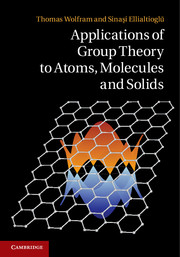Book contents
- Frontmatter
- Contents
- Preface
- 1 Introductory example: Squarene
- 2 Molecular vibrations of isotopically substituted AB2 molecules
- 3 Spherical symmetry and the full rotation group
- 4 Crystal-field theory
- 5 Electron spin and angular momentum
- 6 Molecular electronic structure: The LCAO model
- 7 Electronic states of diatomic molecules
- 8 Transition-metal complexes
- 9 Space groups and crystalline solids
- 10 Application of space-group theory: Energy bands for the perovskite structure
- 11 Applications of space-group theory: Lattice vibration
- 12 Time reversal and magnetic groups
- 13 Graphene
- 14 Carbon nanotubes
- Appendix A Vectors and matrices
- Appendix B Basics of point-group theory
- Appendix C Character tables for point groups
- Appendix D Tensors, vectors, and equivalent electrons
- Appendix E The octahedral group, O and Oh
- Appendix F The tetrahedral group, Td
- Appendix G Identifying point groups
- Index
- References
14 - Carbon nanotubes
Published online by Cambridge University Press: 18 December 2013
- Frontmatter
- Contents
- Preface
- 1 Introductory example: Squarene
- 2 Molecular vibrations of isotopically substituted AB2 molecules
- 3 Spherical symmetry and the full rotation group
- 4 Crystal-field theory
- 5 Electron spin and angular momentum
- 6 Molecular electronic structure: The LCAO model
- 7 Electronic states of diatomic molecules
- 8 Transition-metal complexes
- 9 Space groups and crystalline solids
- 10 Application of space-group theory: Energy bands for the perovskite structure
- 11 Applications of space-group theory: Lattice vibration
- 12 Time reversal and magnetic groups
- 13 Graphene
- 14 Carbon nanotubes
- Appendix A Vectors and matrices
- Appendix B Basics of point-group theory
- Appendix C Character tables for point groups
- Appendix D Tensors, vectors, and equivalent electrons
- Appendix E The octahedral group, O and Oh
- Appendix F The tetrahedral group, Td
- Appendix G Identifying point groups
- Index
- References
Summary
The structure of a “single-walled” carbon nanotube (SWCNT) can be formed by rolling up a graphene sheet into a seamless tube as shown in Fig. 14.1. Multi-walled carbon nanotubes consist of two or more concentric SWCNTs or scroll-wrapped graphene sheets. Typical SWCNTs have diameters around 2 nm, but the range is from 0.7 to 50 nm. Some tubes are open at the ends and some are capped with a bucky hemisphere.
Nanostructures are produced by many different methods, including arc discharge, chemical vapor deposition, laser ablation, and flame burning of carbon-containing gases and solids. Some of these methods are becoming commercially practical for producing large quantities of carbon nanotubes.
Carbon nanotubes are of great scientific and technological interest because of their unique properties [14.1]. The sp2 carbon–carbon bond is stronger than the sp3 carbon–carbon bond of diamond. The tensile strength of an SWCNT is 10 to 100 times stronger than that of steel. Perhaps the most important potential application is in electronics, since SWCNTs can be grown as metallic threads that can carry an electrical current density that is 1,000 times greater than that of copper. The energy gaps between the valence and conduction bands in SWCNTs range from 0 to 2 eV. Semiconducting nanotubes have been fabricated as transistors that operate at room temperature and are capable of digital switching using just a single electron.
- Type
- Chapter
- Information
- Applications of Group Theory to Atoms, Molecules, and Solids , pp. 383 - 409Publisher: Cambridge University PressPrint publication year: 2014



